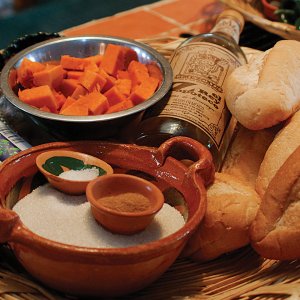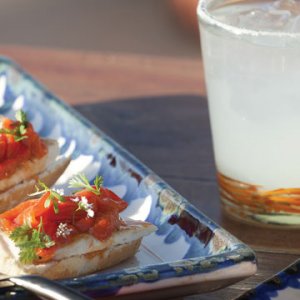Tequila has long been a popular choice south of the border, but this favorite honeymoon destination is also home to a vibrant wine scene. Here, where to go and what to sip.
By: Jimmy ImIf You Have Five Days: The Guadalupe Valley, Baja
Mexico’s most important and famous of the wine regions, set just two hours south of San Diego, produces nearly 90 percent of Mexico wines (mostly blends) from 51 bodegas. Most are linked by the Ruta de Vino, the main wine trail. Thanks to the weather and topography, growing sustainable and organic produce here is a dream for chefs, and winemakers are blessed.
Once a popular spot for regional honeymooners, Valle de Guadalupe has become a world-class destination offering new luxury hotels, top-chef eateries and wine programs and tours. You’d be hard pressed to find a hotel that isn’t positioned among its own grapevines. And the town is easy to navigate. Five days are recommended in Guadalupe Valley, not only to discover the best of the wineries, but also to enjoy the other draws of the region. Horseback riding here is wildly popular and Adobe Guadalupe, a cozy, romantic and very traditional B&B/vineyard, has guided excursions around their grounds.
Where to Stay
Bed & breakfasts may dominate Guadalupe Valley, but for a more sophisticated stay, check into Endemico Encuentro a chic, eco-friendly wine resort that merges nature, architecture and modern design. Twenty-two stand-alone accommodations are built into the hillside and boast floor-toceiling windows for stellar views of the valley. Private decks are equipped with chimneys. The night sky is so clear here you feel as if you could reach out and graze constellations with your fingers (room rates start at $210 a night; encuentroguadalupe.com).
The six-room La Villa del Valle is perched on a hilltop overlooking 72 verdant acres. All accommodations are spacious and have breathtaking views of the nearby mountains and the property’s fruit and olive trees and lavender bushes. The restaurant, Corazon de Tierra, is one of the top 30 in Latin America, thanks to celebrated chef Diego Hernandez (room rates start at $225 a night; lavilladelvalle.com).
Where to Taste:
There’s no shortage of great wine stops in Guadalupe Valley. Famed vineyards include Tres Valles, Monte Xanic, Casa de Piedra and Hacienda La Lomita, whose wines are crafted by an alum from Artadi in Rioja, Spain. Check out the wine tasting-room Vina Cava at La Villa de Valle, one of the most unique spots in the region. The entire ceiling is constructed out of 1930s wooden fishing boats. And there's a gourmet food truck parked out front. Although it’s an intimate space, only producing 2,500 cases a year, the various blends are some of the region’s best and are barreled in 100 percent French oak.
Try all seven labels at Corazon de Tierra, an award-winning restaurant known for farm-to-table dishes. La Villa De Valle also produces the house wine for acclaimed restaurant Pujol in Mexico City, one of the top-rated restaurants in the world. The ex-pat owned, five-acre Lechuza, which until recently produced wines just for personal consumption, makes about 600 cases a year. The 2008 Wedding Blend merlot was dedicated to the owner’s daughter, who was married on site.
Where to Eat:
The rustic, al fresco Finca Altozano has been the buzz about town since it debuted in 2012. Helmed by top chef Javier Plascencia, flavors burst forth in traditional Mexican dishes and specialized small plates. Expect innovative, seasonal fare like marlin carpaccio with radish or lamb tortillas garnished with homemade sauces.
Highly touted as the best restaurant in Baja, Lama has been wooing gourmands for more than a decade. The memorable tasting menu is all farm-to-table. Reservations are recommended. Opened in September 2013, Latitude 32 at Cielo specializes in seafood and steaks presented by South African chef Ryan Steyn, who ran L’escargo in Tijuana. Expect mostly organic fare (straight from their own garden) and Sonora steaks. The candlelit dining enhances the romantic atmosphere.







